Thinking outside the chip for MEMS design success
To create optimal systems, designers involved with MEMS devices must grasp the system environment in which they’ll work
By ROGER H. GRACE
Roger Grace Associates
Naples, FL
http://www.rgrace.com
This is the first article of a series addressing key issues in creating systems employing microelectromechanical systems (MEMS) devices as sensors and/or actuators in the system’s front end. This article establishes the rationale for a system-design approach and demonstrates its practicality using case studies of successful implementations based on this design philosophy. Future articles in this series will address specific functionalities of the system-solution approach, including energy harvesting and storage, signal conditioning and embedded intelligence, system design tools, system test, and packaging.
MEMS devices have been available for almost 50 years. Pressure sensors, accelerometers, gyros, and displacement sensors have been popularly used as system components for a wide spectrum of applications in the automotive, aerospace, industrial, medical, and (most recently) consumer markets. However, only until recently has there been an epiphany in the MEMS community that has led to “thinking outside the MEMS chip” and considering all other elements/functionalities required to create an optimum systems solution.
To be of any use in a system, the low-level MEMS analog signal needs to be conditioned, which involves such functions as A/D conversion, filtering, and temperature compensation. Additionally, the use of embedded intelligence for power management and performance optimization is often required.
The next system function that must be addressed is power (both creation and storage), followed by networking (whether wired or wireless), interconnection of all system elements, and creation of a packaging solution that meets system environmental and cost requirements. Finally, the design must be tested as a system. Thus, if an optimum solution is to be achieved, designers must adopt a “systems think” approach for systems with MEMS devices.
This approach necessitates co-design of an integrated solution, with the close collaboration of all participants from day one until completion. Universal adoption of this system-design approach will provide a solution with optimized performance while simultaneously reducing cost, increasing reliability, and reducing time to market. The following are examples of MEMS-based systems solutions that use this approach. They are currently being produced in large volume now or are in development and are expected to be commercialized in the near future.
Monitoring tire pressure
The virtual granddaddy of all MEMS-based systems solutions is the tire-pressure-monitoring system (TPMS). Schrader Electronics (www.schraderelectronics.com) produced the first such system for the 1996 C-5 Corvette after an eight-year development program. In 2009, approximately 50 million TPMSs were sold worldwide.
Schrader’s current TPMS (see Fig. 1 ) consists of a multiplicity of components, including a MEMS piezoresistive pressure sensor, a motion sensor/accelerometer to sense when the vehicle is moving (tire pressure measurement is not necessary when the vehicle is at rest), an ASIC with a microcontroller core and an integral temperature sensor for compensating the pressure sensor, a lithium cell battery, and an antenna to transmit the signal to the vehicle compartment display directly or through a CAN bus.
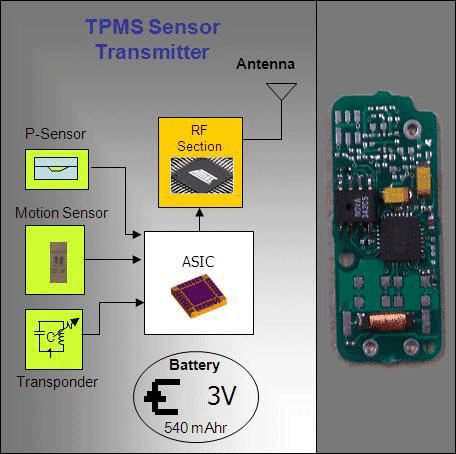
Fig. 1. Schrader Electronics current TPMS includes a MEMS piezoresistive pressure sensor, a motion sensor/accelerometer, an ASIC with a microcontroller core and an integral temperature sensor, a lithium cell battery, and an antenna.
All these components are encapsulated in a plastic package mounted with an integral valve stem, and must survive the rigors of an automotive environment that may see temperatures from –40º to 125ºC, shock of several thousand g’s, and 500 to 600 rpm wheel speeds for 150,000 miles or a 6 to 10-year lifetime. The biggest challenge to produce this solution was to, in the words of Schrader’s Vice President of Worldwide Marketing Carl Wacker, “put electronics where electronics are not supposed to go.” He notes that it “took a cross-functional team of RF engineers, sensor hardware designers to undertake the sensor-tradeoffs studies [the MEMS pressure sensor was outsourced], mechanical designers for the package, ASIC designers and software developers, manufacturing process engineers, and test engineers.“
Schrader’s next innovations for this system are an energy harvester to replace the current battery, and the development of a new mounting technique that permits bonding of the system to the tire, thus allowing additional measurements to be realized.
Where we’re flying
In 2003, Crossbow Technologies (www.xbow.com) was the first company to receive FAA certification for its MEMS-based attitude control system for general aviation. The company has created a number of systems that rely on the integration of three MEMS accelerometers and three MEMS gyros to provide attitude reference for general and military unmanned aviation applications. To provide calibration and correction functions for optimizing system performance, these systems rely heavily on a DSP chip that incorporates flash and E2 memory functions as well as Kollman filter algorithms (see Fig. 2 ).
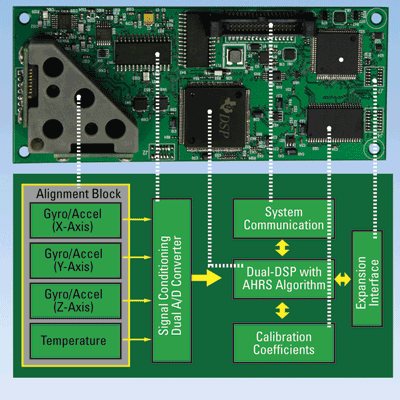
Fig. 2. Croswsbow Technologies’ attitude reference uses digital DSP chips to optimize performance.
Product Manager for Inertial Systems Phil Lees said, “Our current system, the AHC 525, measures 4.8 x 2.0 x 0.8 in. which shrunk from a 5 x 5 x 5-in. system with the same functionality. Our earlier systems used expensive mechanical packaging to isolate the vibration, which was a major cause of error. Our current system uses advanced algorithms to achieve optimum performance while subsequently reducing cost.”
The Crossbow solutions team consists of electronic, system, mechanical, manufacturing and test engineers, software developers, and a program manager. MEMS sensors are outsourced. The technology roadmap for these systems includes higher levels of feature integration and performance.
TV control in free-space
To create human-machine interface devices that can be used as free space controllers for TVs and video games, Hillcrest Labs (www.hillcrestlabs.com) uses off-the-shelf MEMS three-axis accelerometers and two and one-axis gyros. The heart of the third-generation 0.9 x 0.9-in. PC board system is a 32-bit microcontroller that provides a 2.4-GHz RF transmitter and embedded software for data crunching and compensation for temperature, zero-rate offset, the orientation of the device in the users hand, and adaptive hand-tremor removal (see Fig. 3 ).
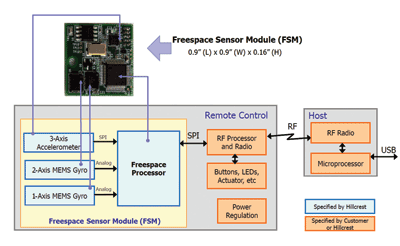
Fig. 3. Hillcrest Labs uses a 32-bit processor and embedded software to extract meaningful hand-orientation information.
Hillcrest Vice President of Freespace Products Chad Lucien notes, “We started in the in-air pointing controller business six years ago and realized that if we were to be successful, we needed to have in-house sensor experts that understood the idiosyncrasies of sensors that we outsourced. These engineers formed the core of our development team, along with the embedded software/algorithm and signal processing engineers, headed by a system architect.” Chad sees that one of Hillcrest Labs’ greatest challenges is to come up with ultra-low-power-consuming systems elements that support these handheld applications.
Passing the torch
The hand-held, LED-illuminated torch that featured in the 2008 Beijing Olympics was developed by MEMSIC (www.memsic.com). According to Yong Yao Cai, MEMSIC Director of Technology Partnership and Development, the heart of the system is a thermally activated two-axis accelerometer with monolithically integrated analog amplifier, A/D converter, heater control circuit, temperature compensation, trimming fuse, and I2C digital interface.
This device connects to a microcontroller with programmable interface and library. Driven by a battery that illuminates a string of LEDs, it is enclosed in a plastic package. This solution is a poster child of the co-design philosophy, with MEMSIC working with design-software provider SoftMEMS through its MEMS Pro tools. “We have created a process to allow MEMSIC designers to seamlessly pass data between the MEMS and IC design groups,” stated MaryAnn Maher, CEO of SoftMEMS.
Works in progress
While the above real-world applications, demonstrating the feasibility of MEMS-based systems solutions, are encouraging, more important to the future are projects currently being pursued by a number of research labs and companies.
The University of Michigan’s Wireless Integrated Microsystems (WIMS) Engineering Research Center (www.wimserc.org) was funded approximately ten years ago by NSF to create two MEMS-based systems platforms. The first, a wrist-watch-sized gas chromatography system, demonstrates the feasibility of having a MEMS-based front end integrated with low-loss ASIC circuits and powered by a MEMS energy harvesting system with a back-end wireless transmitter. The second is a cochlear implant that integrates neural probes remotely powered by an external RF link. Professor Ken Wise, the Center’s director, expects both these systems to be commercialized in the next 4-7 years.
“There are a number of other applications,” Wise says, “but basically we use a generic architecture to embed a controller, a monolithic or hybrid ASIC, and sensors.” Such systems can take a number of forms (see Fig. 4 ), but merging control and DSP with sensing and wireless to create WIMS with a generic architecture “is going to have a pervasive impact in coming years” Wise predicts.

Fig. 4. The University of Michigan’s Wireless Integrated Microsystems Engineering Research Center created an autonomous data gathering microsystem using a generic microsystem architecture. Implemented on a silicon platform with through-silicon vias, the architecture combines an embedded microcontroller, power source (battery), ASIC (sensor interface) and sensors for pressure, temperature, and relative humidity, as well as the ability to handle biomedical electrode signals.
Hewlett Packard has recently announced a novel ultra-sensitive accelerometer technology based on work conducted by Senior Researcher Peter Hartwell and colleagues. The proposed system (a prototype of which is shown in Fig. 5 ) uses the accelerometer and associated electronics — including ASICs, embedded firmware, and a wireless chip — to monitor minute vibrations in roadways to provide traffic data that will help commuters better plan their journeys. Additionally, HP proposes that this self-contained autonomous system can be used to monitor civil engineering structures, including tunnels, dams, and bridges, to predict possible failure modes.
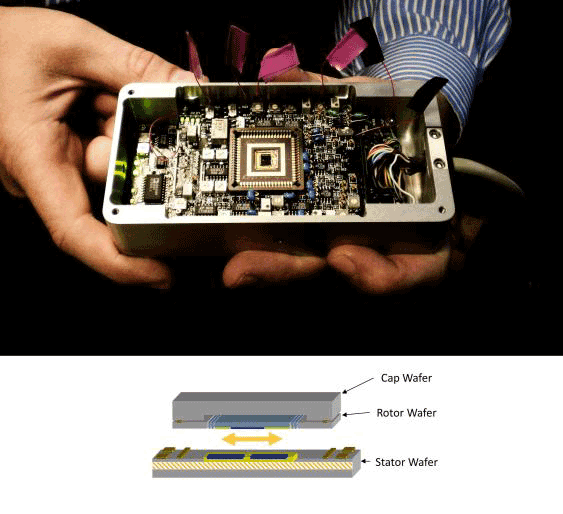
Fig. 5. Hewlett Packard has recently announced a novel ultra-sensitive accelerometer technology and shown a prototype of a system (top) that uses the accelerometer (illustrated at bottom) with associated electronics that include ASICs, embedded firmware, and a wireless chip.
The Fraunhofer Research Institute for Electronic Nano System (ENAS)-Center for Micro Technologies at the Chemnitz (Germany) University of Technology (ZfM) focuses on smart systems integration activity. As Professor Thomas Gessner, the Institute’s director explains, his group is “developing solutions which embrace the integration of different micro- and nanotechnology functionalities such as signal processing, sensors, actuators, photonics, power, coolers (and communications) — all with a high degree of miniaturization and flexibility — to reduce costs. These are offered in robust and cost effective packages that are ideally suited for the specific applications in which they are to operate”.
Some of the key areas of investigation at Fraunhofer ENAS/ZfM and its commercial partners include RFIDs for material tracking, container management, and facility management under its Active Smart ID Label (ASIL) project. The objective of this project is to develop an active RFID system for the monitoring of shock, inclination, and temperature during the transportation of goods and materials. Fraunhofer’s industrial partners for this project include Elmos AG, KSW Microtech AG, Schenker AG, MEMSfab GmbH.
System components include an ASIC chip with an A/D converter and signal processing; a temperature sensor, logic/memory, and RF front-end RFID chip; a MEMS chip with shock-sensing and inclination capability; a battery; and an antenna. All of these functions are integrated on a thin planar flexible package made using a roll-to-roll process (see Fig. 6 ).
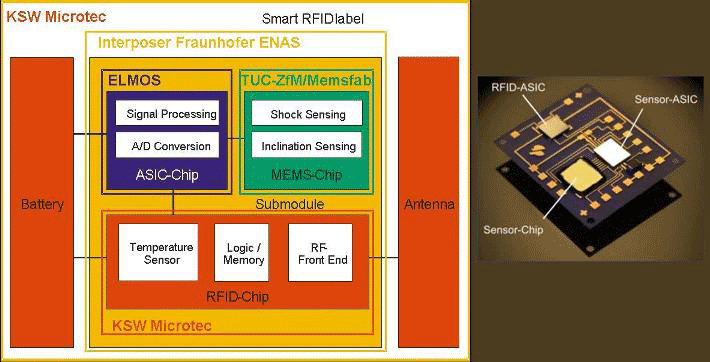
Fig. 6. Fraunhofer ENAS/ZfM in Germany is developing the MEMS-based active RFID system shown above for the monitoring of shock, inclination, and temperature during the transportation of goods and materials.
Other projects currently under development at Fraunhofer ENAS/ZfM that embrace the smart systems integration concept include a MEMS- based spectrometer and a MEMS-based lab-on-a-chip. (Note: Professor Gessner is the chairman of the Smart Systems Integration Conference 2010 mentioned below.)
With the ongoing commoditization of many MEMS devices, especially accelerometers, it will be necessary for companies producing them to differentiate their products to achieve market success. One way to do this is to add increasing levels of functionality into not-necessarily-monolithic solutions, especially in the area of ASICs and DSP/microcontroller interfaces. As these applications show, the concept of MEMS-based systems solutions is alive and well and beginning to gain wide acceptance, and thus the next couple of years will see a proliferation of such solutions. In the final article of this series, the author will address some interesting works in progress . . . stay tuned. ■
Want to learn more?
Smart Systems Integration 2010 is an international meeting at which researchers and manufacturers exchange know-how on smart systems integration and create the basis for successful cooperations. Scheduled to take place in Como, Italy, on March 23 and 24, 2010, this fourth annual conference is part of the activities of EPoSS, the European Technology Platform on Smart Systems Integration. The author of this article will present a paper on MEMS-based system solutions that addresses an expanded number of current and future applications similar to those presented here. For more information on the conference, visit www.smart-systems-integration.org/public.
The Techconnect World Microtech Conference and Exhibition will take place in Anaheim California from June 21-25, 2010. The author is organizing and will chair an all-day session on Microsystems Integration on June 24. Abstracts are being solicited for this session, with submissions due March 19. For more information, visit www.techconnectworld.com/Microtech2010/program/RGrace.html.
Sensors Expo 2010 will take place in Rosemont, Illinois from June 7-9. The author is organizing and will chair an all-day session on “MEMS-Based Systems Solutions” on June 7. Abstracts are being solicited for this session and are due March 8. For more information visit www.sensorsexpo.com.
Advertisement
Learn more about Roger Grace Associates





